Yoga for Migraine and Headaches
The head-splitting ache that stems from migraine is a debilitating experience. It just drains the entire energy out of our system, shattering the plans we had in store for the day. But does ibuprofen or other such NSAIDs offer a permanent cure? No, and these medications come with side effects, while some of the more potent anti-migraine drugs could cause hypertension, nausea, and insomnia.
Put the worries about the disastrous headaches to rest as yoga gives us a natural way to handle and combat migraine and headaches. Yoga for Migraine and headache includes postures and breathing exercises. But before we get into the simple daily routine for these conditions, let us take a look at what causes migraine and the symptoms of this condition.
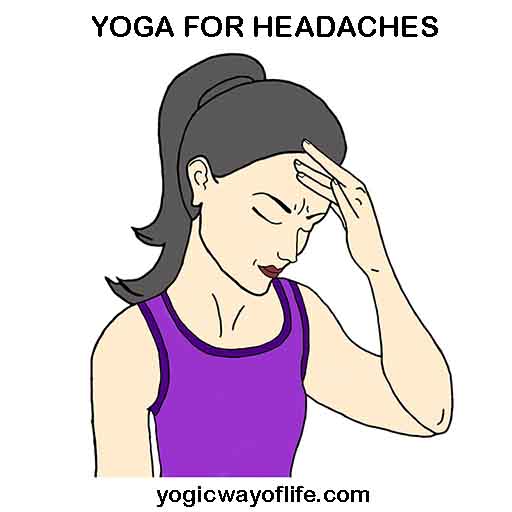
What causes migraine?
It is considered as the 3rd most common and 6th most disabling health condition in the world. It is a neurological disorder which trigger headaches recurrently. The headaches could be moderate or highly intense.
Some of the most common triggers of migraine as well as headaches include;
- Hormonal imbalances like hypothyroidism or hyperthyroidism
- Certain foods like cheese, deep fried foods, dairy products, and fast foods
- Pre-menstrual hormonal changes
- Menopause
- Pregnancy
- Use of artificial sweeteners and sugar and food additives
- Excessive consumption of caffeinated beverages and/or alcohol
- Disruption in sleep cycles
- Lack of adequate sleep
- Stress
- Excess physical exertion
- Change in weather
- Underlying medical conditions like hypertension and diabetes
- Use or medications like oral contraceptive pills or vasodilators
- Hidden heart problems
- Dehydration
- Sensory stimulations like strong scents or flickering lights
- It could be in your family
Symptoms of Migraine
Some of the common symptoms of migraine are
- Dull or sharp pain in the neck and/or face
- Acute and severe, throbbing recurring headaches that last anywhere between 2 to 48 hours
- Light headedness or dizziness
- Extreme sensitivity to lights and sounds
- Blurred or distorted vision
- Nausea or vomiting
- Nasal congestion
- Scalp tenderness
A Yoga Regimen for Migraine and Headaches
A deep breath always helps in eliminating headaches of all sorts while improving the circulation to the neck, spine, and shoulders, easing the tension and opening the area, and releasing the pain. Below outlined is a simple, but effective routine that anyone could practice daily to prepare mentally and physically when migraine launches its next attack.
-
Uttanasana with Padahastasana or Standing Forward Fold
As the name implies, you bend forward, allowing the blood to gush into the frontal lobe of the brain. And, this enhanced circulation eases the pain and inflammation experienced during migraine. Keep the knees slightly bent and allow the head to hang loose. Do not force the body to get deeper into the pose or achieve the perfect posture when suffering from headache. The idea is to relax.
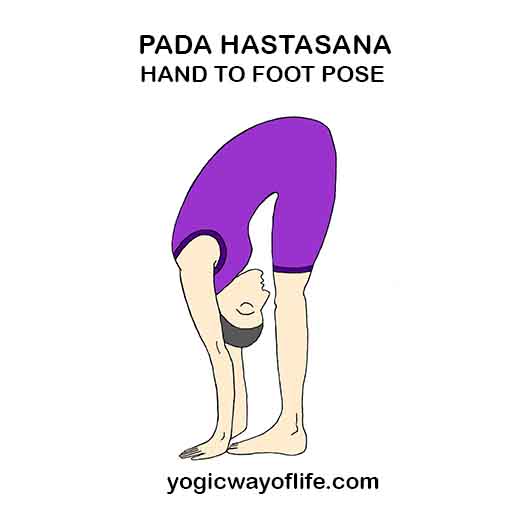
Stand tall with feet touching each other. Inhale and sweep the hand overhead. Exhale and fall forward from the hips, pushing the hips backwards. Keep the knees slightly bent and allow the abdomen to rest on the thighs. Relax the shoulders, neck, and head. If possible, let the palms rest flat on the floor, on either sides of your feet. Hold the posture, breathing deeply, for 3 minutes. Inhale and come back to starting position, slowly, curling the vertebrae, one at a time.
-
Paschimottanasana or Seated Forward Fold
Second posture in Yoga for Migraine series is Paschimottanasana. Continue the practice by relaxing and calming the brain by sending more blood and triggering the release of endorphins and serotonin with this simple practice. Keep a bolster or a couple of pillows handy to rest the forehead on them while bending forward.
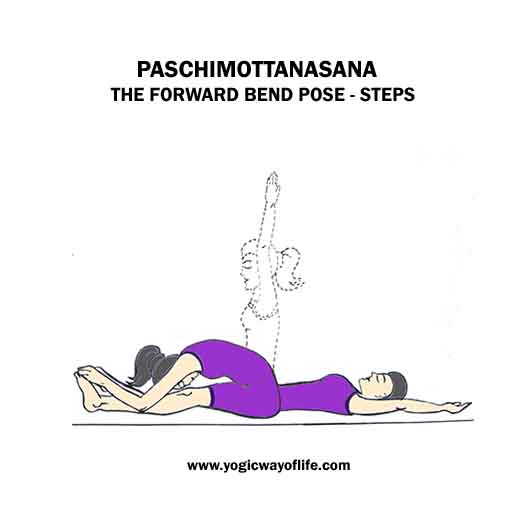
Sit down with legs stretched out, sitting bones firmly resting on the floor. Inhale and sweep the hand overhead. Exhale and fall forward from the hips, resting the abdomen on the thighs. Hold the leg, wherever the hands reach and relax the body. Deepen the fold with exhalations. Hold the posture, breathing deeply, for 3 minutes. Inhale and come back to starting position.
-
Baddha Konasana or Bound Angle Pose
Move on to Baddha Konansana which is the third posture in yoga for migraine series. The forward bending version of this pose stimulates detoxification by promoting circulation to the brain. The straight torso version of the posture is restorative and rejuvenating that ease stress and calms you.
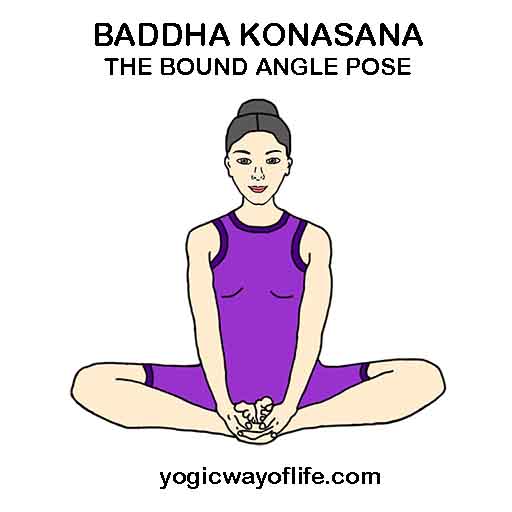
Sit down with legs stretched out. Bend the knees and join the soles of the feet. Place the palms on the knees. Breathing out, fold forward, lengthening your spine in such a way that your chin rests on the tips of the toes. Simultaneously, push the knees down and close to the floor using the palms to stretch the groin and hip. Hold the posture, breathing deeply, for 3 minutes. Inhale, straighten the torso, and stretch out the legs.
-
Sarvangasana or Shoulder Stand Pose
Inversions are classical poses that promote wellness. It is called as the Elixir of Youth and helps in healing and restoring the natural state of your body.
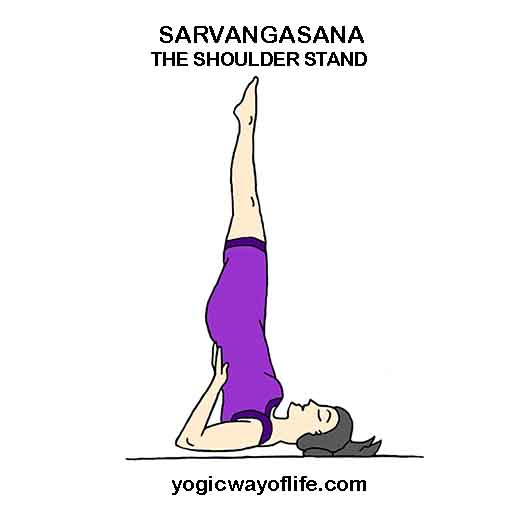
Lie down on the back, stretching the legs out. Exhale and on an inhale, swing the legs to allow it to come perpendicular to the floor. On the next exhalation, raise the waist off the floor, pushing the legs towards the head. Support the waist with hands. Slowly, straighten the legs in such a way that the entire body is at a 90 degree angle with the floor. Hold the posture for 3 minutes. To exit, slowly release the torso to the floor, vertebra by vertebra.
-
Shavasana or Corpse Pose
Relax and unwind the body and mind with Shavasana. You can practice this posture even when you are writing with intense headaches. It helps in calming down and easing the pain.
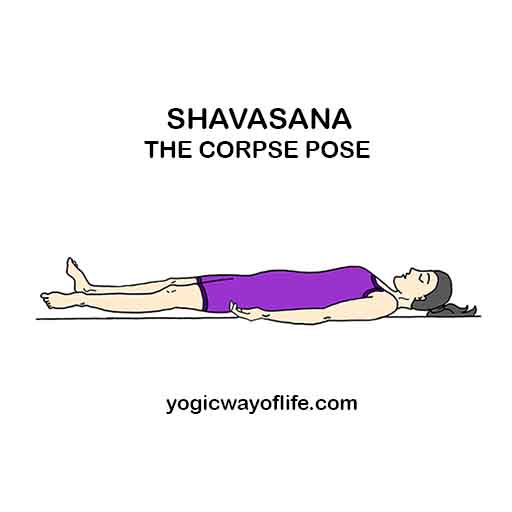
Lie down on the back, legs separated wider than the hips. Let the feet fall naturally away from the body towards the floor. Stretch out the hands, palms facing the ceiling, leaving enough space for armpits to breathe. Allow the body to relax naturally. Close your eyes and breathe through the abdomen. With each inhalation, let the abdomen rise and as you breathe out, let the navel fall close to the spine. Focus on the breath and rest in the Corpse pose as long as you want.
Along with these yoga poses, try to make adequate changes to the lifestyle to prevent frequent recurrences of migraines and headache.
-
Simple Yogic Breathing
A yogic breath is a full breath. It is done with full awareness. Breathe in slowly and rhythmically filling the belly, chest and shoulder region. Similarly breathe out fully with awareness and relaxation. Do it slowly for few rounds. You will feel the mind relax and tensions disappearing. This can relieve headaches and migraine. Click here to see more on Yogic breathing.
-
Anulom Viilom Pranayam or Alternate Nose Breathing
Anulom Vilom Pranayam or alternate nostril breathing balances the activities of the two hemispheres of the brain. It is done by closing one nostril at a time. Start by closing the right nostril and breathe in through the left nostril fully. Then close the left nostril and slowly leave the air from the right nostril. Now inhale through right nostril and then after closing the right nostril exhale through left nostril.
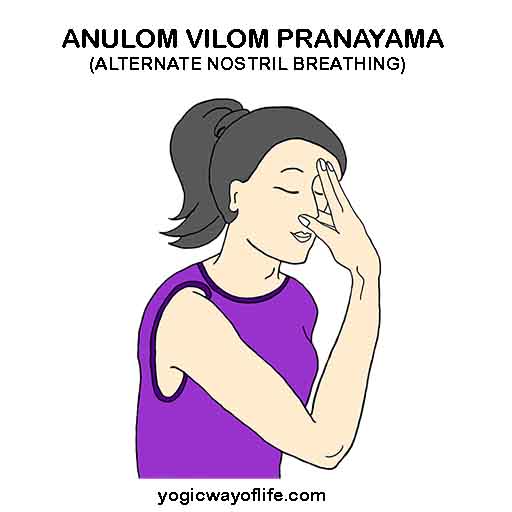
Do this without holding the breath. Practice for few minutes and observe the difference. This will definitely help to relieve headaches and migraine.

good idea